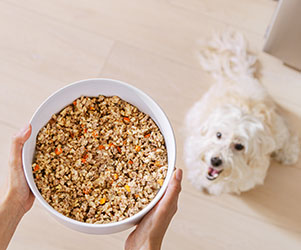Bird Flu Found in Raw Pet Food
Several cats recently fell ill or died from avian flu after consuming commercial raw pet foods in multiple states.
With cases on the rise, there’s growing curiosity about whether pets can be affected by avian influenza—commonly known as bird flu. The short answer is, yes. Several cats recently fell ill or died from avian flu after consuming commercial raw pet foods in multiple states. The FDA is urging raw pet food manufacturers to revisit their food safety strategies.
While dogs can contract HPAI or H5N1 virus, they typically present milder symptoms. Cats are more sensitive and at greater risk. Let’s break down the facts and help you protect your pets.
What Is Bird Flu?

Bird flu (Highly Pathogenic Avian Influenza) refers to strains of influenza viruses that primarily affect birds. These viruses, such as H5N1 and H5N8, can cause severe respiratory illness in domestic poultry and wild birds (it has also been found in raw milk from dairy cows).
Certain strains of bird flu can cross species barriers and infect mammals, including humans.
Can Dogs Get Bird Flu?
The risk of dogs contracting bird flu is low, but not zero. While dogs are not natural hosts for the virus, there have been rare cases where they’ve become infected after close contact with infected birds. For instance, dogs consuming raw or undercooked poultry contaminated with the virus may be at risk.
Symptoms of Bird Flu in Dogs and Cats
If a dog were to contract bird flu, the symptoms might include:
- Coughing or difficulty breathing
- Lethargy
- Fever
- Vomiting or diarrhea
- Nasal discharge
It’s worth noting that these symptoms overlap with those of other common respiratory illnesses in dogs. Therefore, a proper diagnosis from your veterinarian is crucial.
Clinical signs of infected cats include:
- fever
- lethargy
- heavy discharge from the eyes and nose
- respiratory distress
- neurological issues
According to the American Veterinary Medical Association (AVMA): “[Avian influenza viruses] in affected cats can rapidly progress to death. Rabies also should be considered among differential diagnoses for cats with neurologic signs.”
How to Protect Your Pets from Bird Flu

Pet owners can protect themselves and their pet from the bird flu virus by following CDC (Centers for Disease Control and Prevention) recommendations:
- Avoid Direct Contact with Wild Birds: Keep your dog on a leash during walks to prevent them from scavenging or interacting with wild or dead birds, especially in areas known to have bird flu outbreaks. Stay away from feces and bird droppings as well.
- Handle Poultry Safely: If you feed your pet raw meat or home-prepared meals, ensure the poultry is thoroughly cooked to eliminate any potential pathogens.
- Maintain Good Hygiene: Wash your hands after handling pet birds or cleaning bird feeders.
- Stay Informed: Keep an eye on local news about infected animals, how the virus spreads, and follow public health advisories on infectious diseases.
When to See a Vet
If your pet shows signs of respiratory distress or has been exposed to potentially infected birds or raw poultry, consult your veterinarian immediately. Early detection and treatment are key to managing any illness.
The Bigger Picture

The pathogen risk of raw pet food is well documented in the scientific and veterinary community. Raw dog food and cat food remains a public health issue.
The potential for spread of disease is one of many reasons why we gently cook our diets at JustFoodforDogs. As evidenced by recent news, feeding raw meat to our pets is just not worth the risk.
The H5N1 bird flu news is a reminder of the interconnected nature of animal and human health. By staying vigilant and informed, you can ensure your pet stays happy and healthy, even in the face of emerging health concerns.
This content is for informational use only and does not replace professional nutrition and/or medical advice, diagnosis, or treatment. It is not a substitute for and should not be relied upon for specific nutrition and/or medical recommendations. Please talk with your veterinarian about any questions or concerns.
CDC. 2024. “H5N1 Bird Flu: Current Situation.” Avian Influenza (Bird Flu). June 21, 2024. https://www.cdc.gov/bird-flu/situation-summary/index.html.
“Cat Deaths Linked to Bird Flu-Contaminated Raw Pet Food, Sparking Voluntary Recall.” 2025. American Veterinary Medical Association. January 15, 2025. https://www.avma.org/news/cat-deaths-linked-bird-flu-contaminated-raw-pet-food-sparking-voluntary-recall.
Tin, Alexander. 2025. “More than a Dozen Cats Dead or Sickened by Bird Flu in Raw Pet Food, FDA Says.” Cbsnews.com. CBS News. January 21, 2025. https://www.cbsnews.com/news/fda-cats-dead-sickened-bird-flu-raw-pet-food/.
“H5N1 in Cat and Dog Food: New FDA Requirements and Safety Plans.” 2025. AAHA. January 21, 2025. https://www.aaha.org/trends-magazine/publications/fda-requires-cat-and-dog-food-manufacturers-to-include-h5n1-in-food-safety-plans/.







